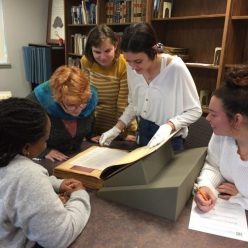by Ethan Dykes, HIS368 Intern
As a resident of the Hampton Roads area I have always been fascinated by the region’s rich history. It’s been home to many important historical events, towns, buildings, and people. Jamestown and Williamsburg were some of the first successful colonial settlements. The first enslaved Africans believed to be brought to the Americas were deported on the coast of Point Comfort, not more than thirty miles from where I live. My own home town was the site of a battle in the Revolutionary War, where Virginia rebels pushed out British forces and helped secure key points in the area. The great city of Norfolk is home to the largest Navy base in the world and has long been an important city in America’s history. One aspect of my local history, however, that I have largely overlooked has been the fight against racism. We all know of Martin Luther King Jr., Malcolm X, Rosa Parks and others that fought so famously against segregation and racial oppression. We all know of the March on Washington, the events on the Edmund Pettus Bridge, and the many other great examples of the fight for justice. But so often do we forget the smaller victories against racism, so often do we not realize the local impacts these events have on us.
The Importance of Archives in Preserving Local History
Thanks to my experiences as an intern with the Special Collections Department at Old Dominion University, I have had the privilege of seeing some of this history firsthand. I was able to watch several videos from different news outlets from the 1960’s and 70’s. The videos included several interviews, statements, and images on desegregation, and many were focused on the city of Norfolk specifically. I saw President Eisenhower give a statement on desegregation and the closing of schools in several cities such as Norfolk. I saw the Virginia General Assembly issue a response to the Brown vs. Board of Education decision by the Supreme Court, and their plans to implement the Massive Resistance policy to prevent desegregation. I also saw several videos of activists fighting for the desegregation of schools and other public buildings, such as the YMCA. Each video captured the feelings of Norfolk citizens at the time, and how the changes in government, such as the Brown vs. Board decision and the implementation of Massive Resistance, caused them to react. The fight against racism and segregation in Norfolk was captured and documented in these archives, and I of all people was given the opportunity to observe and organize them. I had never before now truly appreciated the rich history of Norfolk and its citizens who fought against racism. Norfolk and the rest of Hampton Roads has had a long and deep history, filled with ordinary people doing great things.
Everyday Deeds
Until recently, I did not consider the area of Hampton Roads, and Norfolk specifically, to be of some importance in the fight against segregation. We are always told to study the big events and the people who had the most impact on the world. The people and events involved in the local history of Hampton Roads may not have been as memorable or had as large of an impact as other occurrences in their times, but their efforts were still felt and preserved in history. The civil rights movement in Norfolk may not have been the most noticed or impactful of efforts in America, but it nonetheless changed the city and its citizens for generations to come. This look into local history reminded me that even the smallest things can have large impacts. It was thanks to the cumulative efforts of ordinary people that the schools in Norfolk were reopened, desegregation was implemented, YMCA buildings and other facilities were opened to people regardless of color, all because the citizens of Norfolk and others willed it. When observing history in such a way, I can’t help but be reminded of the words of a famous grey wizard: “Some believe that it is only great power that can keep evil in check. But I have found that it is the small every-day deeds of ordinary folk that keep the darkness at bay”. Despite what many may think history is not just made of people or events of major significance. Its foundations lie with the efforts of everyday people in everyday towns, creating a cumulative structure filled with local history and local people, of which we should strive to preserve and learn from.


